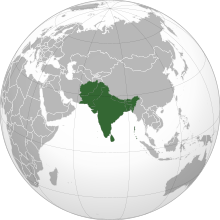
Back Asia Tunong ACE Suid-Asië Afrikaans ደቡብ እስያ Amharic جنوب آسيا Arabic جنوب اسيا ARZ Asia del Sur AST Geefa Asia AVK Cənubi Asiya Azerbaijani جنوبی آسیا AZB Көньяҡ Азия Bashkir
 | |
| Area | 5,222,321 km2 (2,016,349 sq mi) |
|---|---|
| Population | 2.04 billion (2024)[1] |
| Population density | 362.3/km2 (938/sq mi) |
| GDP (PPP) | $18.05 trillion (2024)[2] |
| GDP (nominal) | $5.04 trillion (2024)[3] |
| GDP per capita | $2,650 (nominal) (2024) $9,470 (PPP) (2024)[4] |
| HDI | |
| Ethnic groups | Indo-Aryan, Iranian, Dravidian, Sino-Tibetan, Austroasiatic, Turkic etc. |
| Religions | Hinduism, Islam, Christianity, Buddhism, Sikhism, Jainism, Zoroastrianism, Irreligion |
| Demonym |
|
| Countries | |
| Dependencies | External (1)
|
| Languages | Official languages (national level) Other official languages (provincial/regional level) |
| Time zones | |
| Internet TLD | .af, .bd, .bt, .in, .io, .lk, .mv, .np, .pk |
| Calling code | Zone 8 & 9 |
| Largest cities | |
| UN M49 code | 034 – Southern Asia142 – Asia001 – World |
South Asia is the southern subregion of Asia, which is defined in both geographical and ethnic-cultural terms. As commonly conceptualized, the modern states of South Asia include Afghanistan,[6] Bangladesh, Bhutan, India, Maldives, Nepal, Pakistan, and Sri Lanka.[7] South Asia borders East Asia to the northeast, Central Asia to the northwest, West Asia to the west and Southeast Asia to the east. Topographically, it is dominated by the Indian subcontinent and is bounded by the Indian Ocean in the south, and the Himalayas, Karakoram, and Pamir Mountains in the north.[8]
The South Asian Association for Regional Cooperation (SAARC) is an economic cooperation organization in the region which was established in 1985 and includes all eight nations comprising South Asia.[9] South Asia has a total area of 5.2 million sq.km (2 million sq.mi), which is 10% of the Asian continent.[7] According to the United Nations, the population of South Asia, including Iran, is estimated to be 2.04 billion[10][11] or about one-fourth of the world's population, making it both the most populous and the most densely populated geographical region in the world.[12]
In 2022, South Asia had the world's largest populations of Hindus, Muslims, Sikhs, Jains, and Zoroastrians.[13] South Asia alone accounts for 90.47% of Hindus, 95.5% of Sikhs, and 31% of Muslims worldwide, as well as 35 million Christians and 25 million Buddhists.[14][15][16][17]
- ^ Cite error: The named reference
UN WPP 2019 2was invoked but never defined (see the help page). - ^ "GDP, current prices". International Monetary Fund.
- ^ "GDP, current prices, Purchasing power parity; billions of international dollars, Billions of U.S. dollars". International Monetary Fund.
- ^ "GDP per capita, current prices". International Monetary Fund.
- ^ "Human Development Report 2020 – "Human Development Indices and Indicators"" (PDF). HDRO (Human Development Report Office) United Nations Development Programme. p. 346. Retrieved 16 December 2021.
- ^ "South Asia". Encyclopædia Britannica. Retrieved 1 April 2023.
- ^ a b "Indian Subcontinent Archived 21 January 2012 at the Wayback Machine" Encyclopedia of Modern Asia Macmillan Reference USA (Gale Group), 2006: "The area is divided between five major nation-states, Bangladesh, India, Nepal, Pakistan, and Sri Lanka, and includes as well the two small nations of Bhutan and the Maldives Republic... The total area can be estimated at 4.4 million square kilometres or exactly 10 percent of the land surface of Asia."
- ^ Baker, Kathleen M.; Chapman, Graham P. (11 March 2002), The Changing Geography of Asia, Routledge, pp. 10–, ISBN 978-1-134-93384-6,
This greater India is well defined in terms of topography; it is the Indian sub-continent, hemmed in by the Himalayas on the north, the Hindu Khush in the west and the Arakanese in the east.
- ^ SAARC Summit. "SAARC". SAARC Summit. Archived from the original on 16 December 2013. Retrieved 17 December 2013.
- ^ "Population of Southern Asia (2024) - Worldometer". www.worldometers.info. Retrieved 6 April 2024.
- ^ "World Population Prospects - Population Division - United Nations". population.un.org. Retrieved 7 April 2024.
- ^ "South Asia Regional Overview". South Asian Regional Development Gateway. Archived from the original on 21 November 2008.
- ^ Cite error: The named reference
dip8Jan2016was invoked but never defined (see the help page). - ^ "Religion population totals in 2010 by Country". Pew Research Center. 2012. Archived from the original on 9 December 2016.
- ^ Ruffle 2013, p. 193.
- ^ "Region: Asia-Pacific". Pew Research Center. 27 January 2011. Archived from the original on 10 October 2017. Retrieved 13 March 2016.
- ^ Cite error: The named reference
pew2Apr2015was invoked but never defined (see the help page).
Cite error: There are <ref group=note> tags on this page, but the references will not show without a {{reflist|group=note}} template (see the help page).